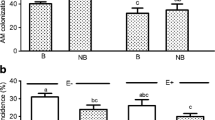Abstract
Penicillium pinophilum was isolated from the soil in a commercial strawberry field. The strain readily formed arbuscular mycorrhizae (AM) with the roots of strawberry ‘Zoji’ (Fragaria × ananassa Duch. CV.) when plants were inoculated with either fresh cultured hyphae or root/soil mixtures. Fresh hyphae, however, resulted in higher amounts of colonization than root/soil inoculum. Compared with uninoculated strawberries, inoculation increased plant dry weight by 31%, as well as nitrogen content (47%), phosphorus content (57%), and photosynthetic rate (71%). AM inoculation also shortened the blossom and ripening date by 3 and 4 days, respectively. This is the first report of a P. pinophilum strain resulting in mycorrhiza with strawberry roots. The significant advantages of this strain are that it is easy to culture and inoculation of plants results in significant growth benefits that may be useful in strawberry production.


Similar content being viewed by others

References
Alagesaboopathi C, Subramanian G (2007) Biological control of damping-off disease of Gossypium hirsutum L. seedling. In: Proceedings of abstract and programme: the 5th international symposium on biocontrol and biotechnology, Khonn Kean Campus, Nong Khai, Thailand, p 67
Borkowska B (2002) Growth and photosynthetic activity of micropropagated strawberry plants inoculated with endomycorrhizal fungi (AMF) and growing under drought stress. Acta Physiol Plant 24:365–370
Gadkar V, David-Schwartz R, Kunik T et al (2001) Arbuscular mycorrhizal fungi colonization factors involved in host recognition. Plant Physiol 127:1493–1499
Gao FJ (2000) Development and prospect of strawberry production in China. Deciduous Fruits 2:20–23
Henrike P, Dietmar S, Christian B et al (2007) Effect of arbuscular mycorrhizal colonization and two levels of compost supply on nutrient uptake and flowering of pelargonium plants. Mycorrhiza 17:469–474
Jakucs E, Kovács GM, Szedlay G et al (2005) Morphological and molecular diversity and abundance of tomentelloid ectomycorrhizae in broad-leaved forests of the Hungarian plain. Mycorrhiza 15:459–470
Johnson CR (1984) Phosphorus nutrition on mycorrhizal colonization, photosynthesis, growth and nutrient composition of Citrus aurantium. Plant Soil 80:35–42
Kaya C, Higgs D, Kirnak H et al (2003) Mycorrhizal colonisation improves fruit yield and water use efficiency in water melon (Citrullus lanatus Thunb.) grown under well-watered and water-stressed conditions. Plant Soil 253:287–292
Koide RT, Mosse B (2004) A history of research on arbuscular mycorrhiza. Mycorrhiza 14:145–163
Mehana TA, Abdul Wahid OA (2002) Associative effect of phosphate dissolving fungi, rhizobium and phosphate fertilizer on some soil properties, yield components and the phosphorus and nitrogen concentration and uptake by Vicia faba L. under field conditions. Pakistan J Biol Sci 11:126–1230
Mosse B, Hepper CM (1975) Vesicular arbuscular mycorrhizal infection in root organ cultures. Physiol Plant Pathol 5:215–223
Nowak J (2004) Effects of arbuscular mycorrhizal fungi and organic fertilization on growth, lowering, nutrient uptake, photosynthesis and transpiration of geranium (Pelargonium hortorum L.H.Bailey ‘Tango Orange’). Symbiosis 37:259–266
Phillips JM, Hayman DS (1970) Improved procedures for clearing and attaining parasitic and vesicular-Arbuscular mycorrhiza fungi for rapid assessment of infection. Trans Br Mycol Soc 55:158–161
Rajni G, Mukerji KG (2002) Techniques for the isolation of VAM/AM fungi in soil. In: Mukerji KG, Manoharachary C, Chamola BP (eds) Techniques in mycorrhizal studies. Kluwer Academic Publishers, London, pp 1–6
Read DJ (2000) Mycorrhiza-the state of the art. In: Varma A, Hock B (eds) Mycorrhiza: structure, function, molecular biology, and biotechnology. Springer-Verlag Berlin Heidelberg, Germany, pp 3–34
Srivastava D, Kapoor R, Srivastava SK, Mukerji KG (1996) Vesicular arbuscular mycorrhiza-an overview. In: Mukerji KG (ed) Concepts in mycorrhizal research. Kluwer Academic Publisher, Netherlands, pp 1–39
Sune P, Åsa KK (1990) Influx and efflux of K+ in sunflower roots after transfer between solutions with different K+ concentrations. Physiol Plant 76:686–692
Wang GX, Ma HY, Qian J, et al (2004) Impact of land use changes on soil carbon, nitrogen and phosphorus and water pollution in an arid region of northwest China. Soil Use Manage 20:32–39
White TJ, Bruns T, Lee S et al (1990) Amplification and direct sequencing of fungal ribosomal RNA genes for phylogenetics. In: Innis MA, Gelfand HD, Sninsky JJ et al (eds) PCR protocol: a guide to methods and applications. Academic Press, USA, pp 315–322
Wu QS, Xia RX (2006) Arbuscular mycorrhizal fungi influence growth, osmotic adjustment and photosynthesis of citrus under well-watered and water stress conditions. Plant Physiol 163:417–425
Acknowledgements
The project was supported by the Science and Technology Planning of Liaoning Province, China (Grant No. 2006201004). The authors wish to thank Prof. Hanson from Michigan State University for proofreading the manuscript.
Author information
Authors and Affiliations
Corresponding author
Rights and permissions
About this article
Cite this article
Fan, Y., Luan, Y., An, L. et al. Arbuscular mycorrhizae formed by Penicillium pinophilum improve the growth, nutrient uptake and photosynthesis of strawberry with two inoculum-types. Biotechnol Lett 30, 1489–1494 (2008). https://doi.org/10.1007/s10529-008-9691-8
Received:
Revised:
Accepted:
Published:
Issue Date:
DOI: https://doi.org/10.1007/s10529-008-9691-8



